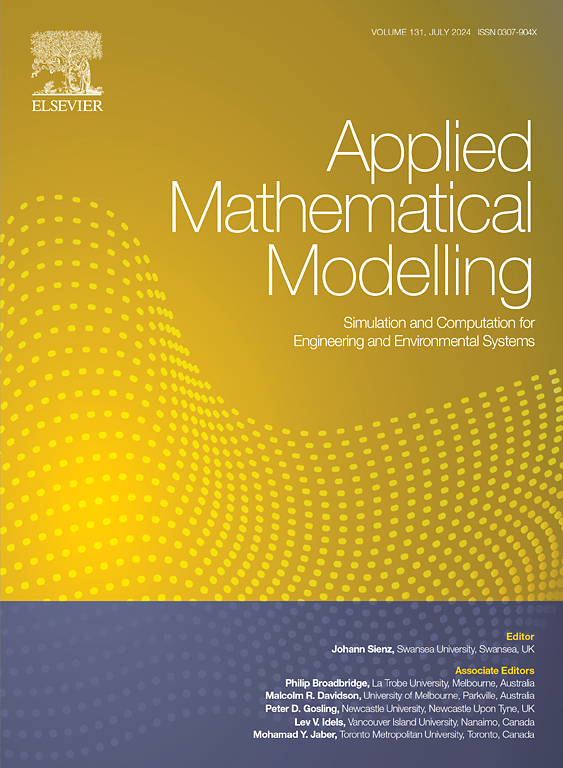The construction method of chaotic system model based on state variables and uncertain variables and its application in image encryption
IF 4.4
2区 工程技术
Q1 ENGINEERING, MULTIDISCIPLINARY
引用次数: 0
Abstract
This paper focuses on the construction of nonlinear dynamic models, specifically targeting continuous chaotic systems. It introduces an innovative approach to integrating state variables and uncertain variables to construct continuous chaotic systems. Initially, a unified construction method is proposed, combining state variables with a determinable amplitude matrix. The feasibility of this method is verified through the definition of the Lyapunov index. Using a three-dimensional chaotic system with a single nonlinear structure as an example, numerical parameters are screened based on the Lyapunov index. Additionally, permutation entropy is utilized to explore changes in the system's chaotic behavior induced by random natural values and mathematical functions in random amplitudes. The model is then extended to a four-dimensional state, demonstrating the complex characteristics of the system in this higher dimension through various complexities, thus highlighting the universal applicability of the construction method. Finally, the constructed three-dimensional and four-dimensional continuous systems are applied to a DNA-based color image encryption system. Comparative analyses of robustness and security show that the proposed method offers significant advantages in practical applications. The results indicate that this method is not only theoretically innovative in constructing chaotic systems but also holds high practical value.
基于状态变量和不确定变量的混沌系统模型构建方法及其在图像加密中的应用
本文主要针对连续混沌系统建立非线性动力学模型。提出了一种利用状态变量和不确定变量的积分来构造连续混沌系统的创新方法。首先,提出了一种将状态变量与可确定振幅矩阵相结合的统一构造方法。通过李亚普诺夫指数的定义验证了该方法的可行性。以具有单一非线性结构的三维混沌系统为例,基于李雅普诺夫指数对系统的数值参数进行了筛选。此外,利用置换熵来探索随机自然值和随机振幅的数学函数所引起的系统混沌行为的变化。然后将模型扩展到四维状态,通过各种复杂性来展示系统在这个高维的复杂特征,从而突出了构建方法的普遍适用性。最后,将构建的三维和四维连续系统应用于基于dna的彩色图像加密系统。鲁棒性和安全性的对比分析表明,该方法在实际应用中具有明显的优势。结果表明,该方法不仅在构造混沌系统方面具有理论创新性,而且具有很高的实用价值。
本文章由计算机程序翻译,如有差异,请以英文原文为准。
求助全文
约1分钟内获得全文
求助全文
来源期刊

Applied Mathematical Modelling
数学-工程:综合
CiteScore
9.80
自引率
8.00%
发文量
508
审稿时长
43 days
期刊介绍:
Applied Mathematical Modelling focuses on research related to the mathematical modelling of engineering and environmental processes, manufacturing, and industrial systems. A significant emerging area of research activity involves multiphysics processes, and contributions in this area are particularly encouraged.
This influential publication covers a wide spectrum of subjects including heat transfer, fluid mechanics, CFD, and transport phenomena; solid mechanics and mechanics of metals; electromagnets and MHD; reliability modelling and system optimization; finite volume, finite element, and boundary element procedures; modelling of inventory, industrial, manufacturing and logistics systems for viable decision making; civil engineering systems and structures; mineral and energy resources; relevant software engineering issues associated with CAD and CAE; and materials and metallurgical engineering.
Applied Mathematical Modelling is primarily interested in papers developing increased insights into real-world problems through novel mathematical modelling, novel applications or a combination of these. Papers employing existing numerical techniques must demonstrate sufficient novelty in the solution of practical problems. Papers on fuzzy logic in decision-making or purely financial mathematics are normally not considered. Research on fractional differential equations, bifurcation, and numerical methods needs to include practical examples. Population dynamics must solve realistic scenarios. Papers in the area of logistics and business modelling should demonstrate meaningful managerial insight. Submissions with no real-world application will not be considered.
 求助内容:
求助内容: 应助结果提醒方式:
应助结果提醒方式:


